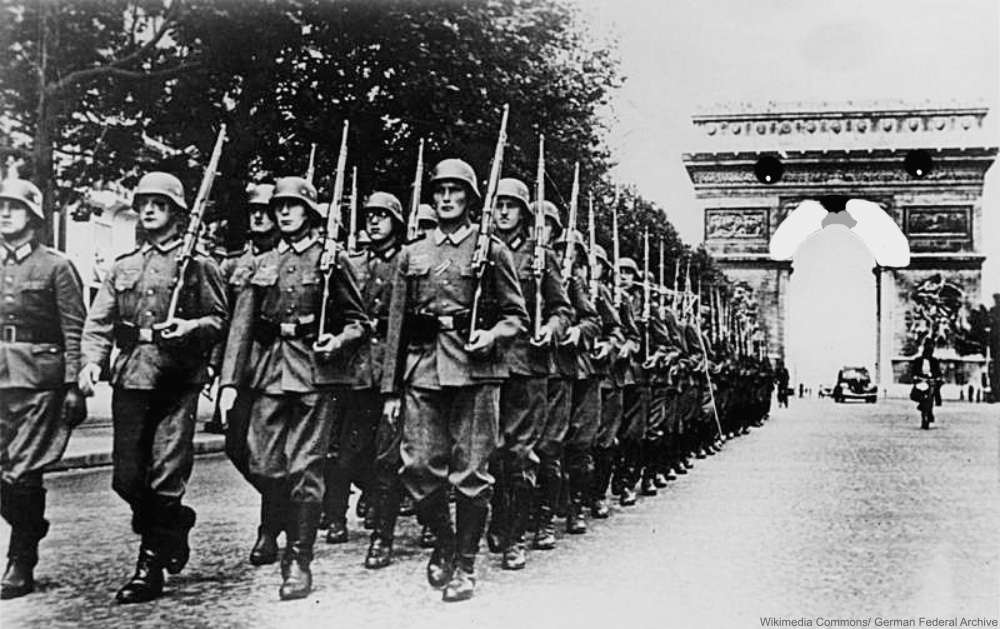Eighty years ago, Nazi Germany emerged victorious in the Battle of France, with the northern half of the country falling directly under Nazi control and the southern half governed by the Vichy regime, which was essentially subservient to Hitler. To mark this momentous historical event, I chose five films that best capture the complexities, the heartbreak, and the tragedies that befell the French people, as well as their varying responses—running the gamut from patriotic heroism to criminal complicity—to the newly installed tyranny. None of these are particularly light viewing, but, in my opinion, they are essential.

5. The Last Metro
François Truffaut’s 1980 Oscar-nominated effort follows the fortunes of a small theater in Paris in 1942. In a show of passive resistance, the Jewish owner is kept hidden in the theater’s basement via the efforts of his wife. Through his spouse, he still is able— unbeknownst even to the majority of the actors—essentially to run and direct the plays going on above him on the stage. Sparkled by dazzling performances from Catherine Deneuve, Gérard Depardieu, and Heinz Bennent and featuring Truffaut’s trademark mixture of different genres (the different subplots of love triangles and violent resistance range from thrilling to comedic), the end-result is an entertaining yet powerful statement on the power of art in times of adversity. Art can function as an escape or a repository of comfort for those whose daily existence is steeped in fear and terror, and the creation of art—the realization of a single vision—has the potential to, in its own way, uphold one’s individual convictions even in the direct face of evil. It is a timeless theme, and one that is expressed beautifully by this film.

4. Le silence de la mer
Jean-Pierre Melville’s exquisite first feature is another portrait of passive resistance. When a French household, consisting of an older man and his twenty-something year old niece, is forced to board a Nazi lieutenant, the two constituents of the household decide to never utter a word to their unwelcome guest. The film is unique in its portrayal of the soldier, in that it does not paint him as machine-like apparatus of evil: naïve and idealistic, he demonstrates a keen interest in French history and arts, and believes that the temporary military occupation will lead to a renewed European cultural renaissance. Inevitably, he arrives at a self-reckoning when he realizes the true aim of Germany’s plans for Europe and the incompatibility of his egalitarian idealism with the pure evil of the Nazis. Compounding this powerful story are acute stylistics. Melville understood that a true representation or understanding of a human being does not come through mere words, but through glances, smiles, and body movements; hence, his focus on the characters’ faces, eye movements, and hand gestures. In a tale where two out of the three main characters are silent, he was able to craft an emotionally resonant story by smartly using this methodology. Additionally, those shots with beautiful contrasts—the isolation and tension inherent in the shots where the players are framed up against a background of pitch black—are breathtaking. Even when budgetary constraints forced the crew to make compromises, it still fit perfectly within the narrative. In contradistinction to the well-shot, well-lit confines of the house (in which the officer espouses his utopian philosophy), the grainy documentary footage of the town (in which the officer realizes the true horrors of the regime) symbolizes the incompatibility of his previous monologues with the real, outside world. In short, for its unique stylistics and complex characterizations, this film remains engaging today for its intellectual prowess.

3. Army of Shadows
Twenty years after his debut with “Le silence de la mer” and after a string of successful neo-noirs, Jean-Pierre Melville once again returned to Nazi-Occupied France with this effort detailing, in startling realism, the machinations of the French Resistance. This is a depiction shorn entirely of any notions of glory or romanticism. There are no bonds of brotherhood—members of the network remain cold and reticent to one another, and even instill distance between themselves and their family, in order to prevent the spread of any personal information lest it should leak and jeopardize the operation; the characters operate and die in nearly total anonymity, with no possibility of posthumous honor or recognition—two brothers involved in the same network do not know of each other’s involvement. Even in lieu of betrayal, simply to prevent the mere possibility of exposure, the characters are forced to kill loyal, honorable members. The cinematography and soundtrack ably compound this dark material. The color palette is overwhelmingly blue and gray, instilling a sense of gloom and manifesting the coldness of the characters. The music, composed by legendary film score composer Éric Demarsan, encapsulates the doom that seems to await each of the main characters, an aural translation of the omnipresence of death, while remaining appropriately melancholic as an elegy recognizing the tragic inevitabilities of the characters’ courage. In all, this is a dark and brutal film. It demonstrates how those in the Resistance consigned themselves to obscurity via oblivion at the hands of the Gestapo and how, in recompense for this sacrifice, they had to further relinquish their personal lives and happiness. It is a cold existence and it requires those involved to risk their lives and commit morally grey acts, and, in return, their names would most likely be forgotten, lost to posterity. Yet, they did it. Because, for the sake of their country, they felt that they had to. And this film is an acknowledgment to the heroism—the true heroism—of those nameless warriors.

2. The Sorrow and the Pity
At over four hours long and banned from French television for more than twelve years after its initial release, “The Sorrow and the Pity” is an intimidating and demythologizing documentary that examines the small city of Clemont-Ferrand during Nazi occupation. Although it details the lives of those who bravely resisted, it shows that this was the vast minority: most simply tried to maintain a sense of normalcy, which required them to acquiesce quietly along with the Vichy government which, the film argues, willingly collaborated with the Nazi regime in contradistinction to popular post-war French dogma. It also skewers the French myth that hardly any Frenchmen themselves colluded with or joined the Nazi forces; the film found that many decided to aid the Nazis, and for reasons that the Allied countries liked to believe only existed in Germany. A son of an aristocrat claimed that, at the time, fascism and communism were the only systems that were going to change the world, and there was no way he could be a communist, so what choice did he have? He also said Hitler was more exciting, likening him to Cecil DeMille. Others collaborated because they saw an opportunity for personal gain; there were also those who had always been poisoned by Anglophobia or a virulent hatred of the Russians and eagerly signed up for Nazism; and finally, there was the all-too-prevalent strain of anti-Semitism—a fact that, after the war, caused so much shame that Allied countries pretended that it never existed within their borders. And therein lies the real reason as to why this film is so harrowing and makes for such uncomfortable viewing: evil has no boundaries and knows no borders. It is horrible enough to be subjugated by a malevolent outside force, but it is even worse to discover that that same malevolence has been lurking within all the while.

1. Au revoir les enfants
A devastating bildungsroman set during the waning years of World War II, the film focuses on Julien as he begins a new school year at a boarding school. Three new students arrive, including Jean Bonnett, a gifted math student and piano savant. Although contentious with each other at first, Julien and Jean soon bond over their mutual love of books and develop a tight friendship. Unbeknownst to Julien at first, however, is that Jean is harboring a secret that, depending on how well it is kept, could mean the difference between life and death. Directed by Louis Malle, one of the legendary French New Wave filmmakers, this film contrasts with his earlier works, opting to utilize subdued stylistics with unadorned, unostentatious camera angles and movements to create a natural and realistic feel. This complements the nature of the plot, which is a really a portrayal of day-to-day life at the school while cataloguing the gradual accumulation of brief interactions that eventually forms the basis for the friendship between Julien and Jean. These elements combine to make the central pairing feel natural and emotionally genuine, the organic product of a real evolution of interactions. The film also elicits an emotional response from the sudden thrust of tragedy that catalyzes Julien’s loss of innocence, the abrupt intrusion of a threat before only thought of in the vaguely abstract, but now rendered all too real. At first, Julien, rich and Catholic, does not have much to worry about regarding the Nazis. He lackadaisically jokes around when air raid sirens go off and the class is forced to the basement to shelter, and, during one session of recess, bemusedly stares up at the sky and wonders when the Americans are going to parachute in. The war, to him, essentially is on the periphery, something far away that will not bother him. That changes, however, in one of the most heart-wrenching endings in all of film (I will try my best not to spoil). Eschewing the depiction of any violence, Julien—and the audience—realizes the malevolence of the Nazi regime: the heartbreak at the instantaneous yet permanent exit, the lack of closure of the swift yet perpetual privation of a dearly-valued friend. Julien now realizes the harsh reality of the Nazi occupation, and how directly omnipresent to his reality it always was. A final voiceover, a tear-filled visage, and a lingering shot of a newly empty doorway; encapsulated in that final sequence are the true horrors of war.





